
I can touch you. But do I want to?
The original Lenovo ThinkPad X1 Carbon was the first real Ultrabook we’d seen come out of Intel’s initiative to slim down and beef up laptops. Now that the touch-oriented Windows 8 has been out for a few months, Lenovo followed up with a touch version of the computer we so loved, named a mouthful of words that go like this: Lenovo ThinkPad X1 Carbon Touch. Other than the touch screen, this is just a heavy version of a computer that we really enjoyed using. But since the only major difference is the existence of the touch screen, and that feature comes at a premium of $150, customers will have to look inside themselves to decide. When choosing between the two models, are you a Windows 8 believer?
The X1 Carbon Touch is virtually identical to its Windows 7-running predecessor, the X1 Carbon, which we reviewed last summer. We advise checking that in-depth edition out for more details on everything that hasn't changed since then. The touch version maintains the exact same physical dimensions, including a thickness of 18.9 millimeters, but it's .41 pounds heavier at 3.4 pounds to the regular X1 Carbon's 2.99 pounds. This is still a more than decent weight for a 14-inch ultrabook. It's questionable whether that fractional difference even makes a difference.
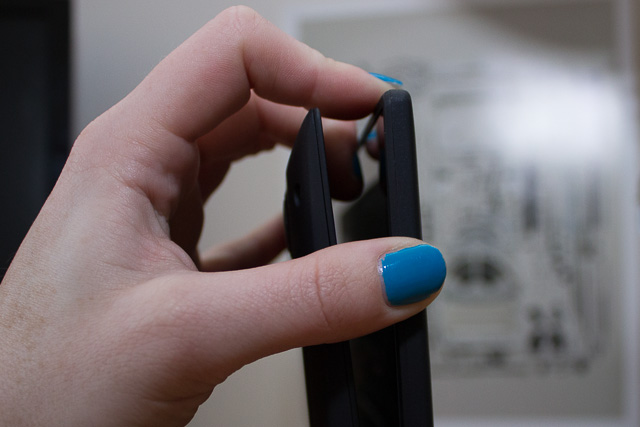
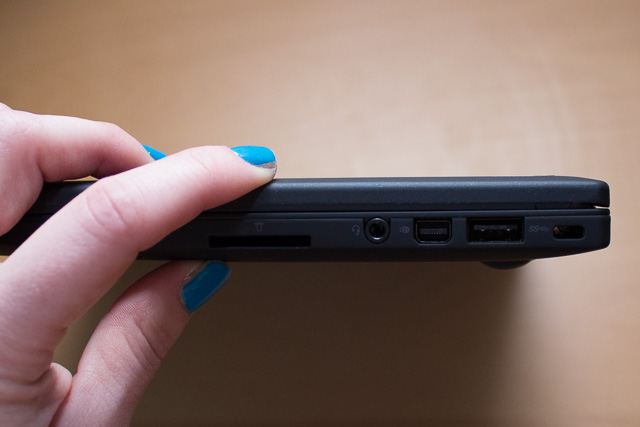
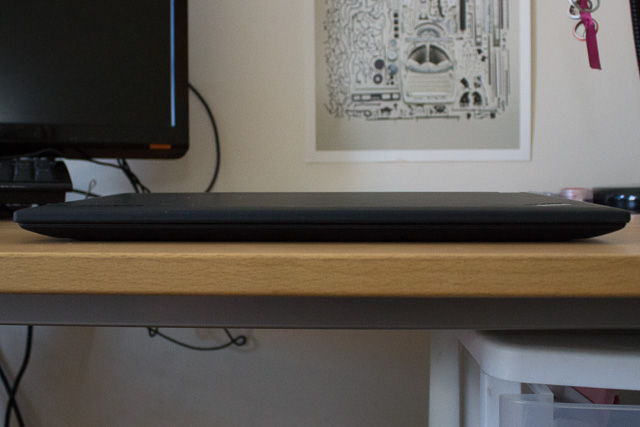
The touchscreen itself works without fault, and all of the requisite Windows gestures go off without a hitch. Swipes, scrolls, pinches, and taps all work fine. Despite our best, most disgusting efforts, it was hard to get the matte screen to pick up our fingerprints. We did manage to leave some smudges by applying a healthy amount of pressure. While they were visible from an angle— and in the right light—on the surface of the screen, they didn't impede our regular viewing experience.
On the downside, the screen is, visually, a little strange: its blacks are not deep and colors are washed out. Granted, if you're getting an ultrabook, you're probably not dealing much with tasks that require color accuracy, but it's noticeable even without a better screen around to compare.
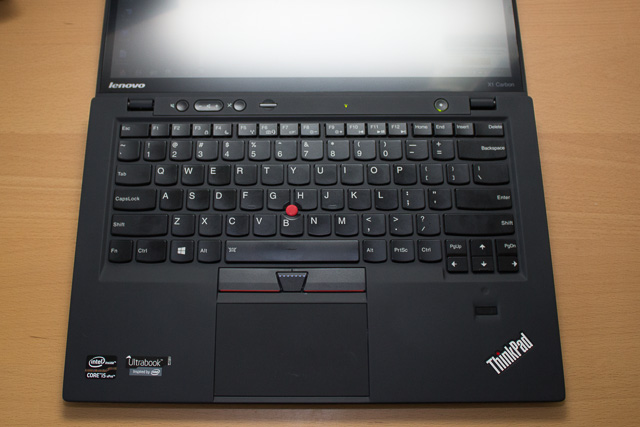
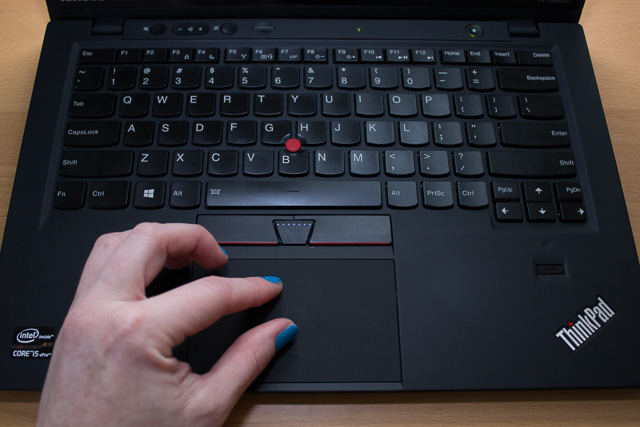
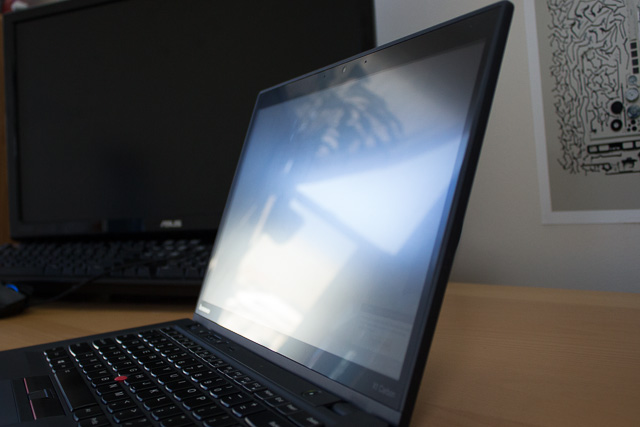
Practically speaking, it's hard to get used to integrating the touch screen into a work flow, especially when the touchpad, buttons, and even Lenovo's characteristic touchpoint are within closer reach than the screen. These aspects are just easier to use for the relatively small desktop elements (moving, resizing, closing windows, opening applications). The only time I felt myself compelled to swipe was when waking up the computer and needing to get through the lock screen, which needs to be swiped or pulled away. The gesture is easier with a swipe, but so long as I'm not dealing with the metro interface, the existence of the touch screen has no bearing on my use.
Ironically, I might be compelled to reach out and touch my monitor instead of the touchpad if its multitouch didn't work as well as it did. We've seen disastrous implementations of things like two-finger scrolling on Windows machines in the past, but two finger scrolling works perfectly on the X1 Carbon still. More importantly, the existence of the gestures doesn't interfere with simpler input elements that have always existed, like click-and-drag.
Likewise, if I were compelled to be in the Metro interface more often, the touch screen would be the superior input method. But being that I use laptops for work and all of my needed applications were on the desktop side, Metro became only a minor annoyance that accidentally cropped up on occasion.
Funny enough, Lenovo's interface gives back the start button that Windows 8 takes away, though it's a handicapped version. In the bottom left corner of the screen is the Lenovo QuickLaunch button, which allows you to do things like search for applications to open and access frequently-used ones on the desktop side.
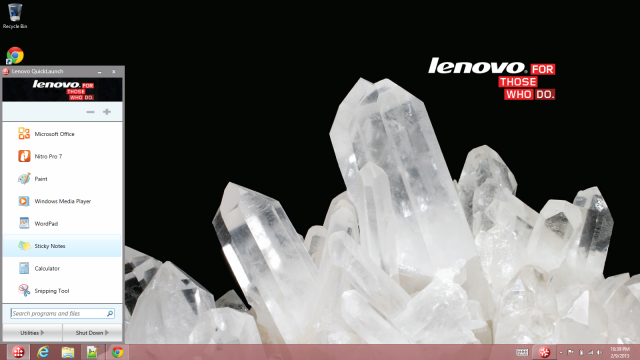
Lenovo's quick start menu that helps out those who might miss the home button.
The laptop also comes with some other, less welcome pre-installed software, including a particularly persistent copy of Norton AntiVirus that does you the “favor” of checking and putting a badge next to every hyperlink on your Google search page. This program is easily dispatched with an uninstall, but we’re ready for the pre-installed sponsored software trend to end already.
In terms of battery life, we suspected that the touch screen might end up being a power drain. While we still find the battery life respectable overall, it fell short of Lenovo’s estimates in our tests.
Lenovo pegs the X1 Carbon Touch’s battery life at “up to 8.2 hours.” We gave it the relatively easy “typical workflow” test of Internet surfing, e-mailing, IMing, and text entry with Wi-Fi on. Brightness was set to about 40 percent. In this test, we got about six hours and 40 minutes out of the battery. When playing a movie with Wi-Fi on, brightness at around 75 percent and full volume, we got about five hours 15 minutes out of the computer.
| Spec | Base ThinkPad X1 Carbon model | ThinkPad X1 Carbon Touch reviewed | Highest-end ThinkPad X1 Carbon |
| Processor | Intel Core i7-3667U | Intel Core i5-3427U | Intel Core i5-3427U |
| RAM | 4GB | 4GB | 8GB |
| Storage | 128GB | 128GB | 256GB |
| Graphics | Intel HD 4000 Graphics | Intel HD 4000 Graphics | Intel HD 4000 Graphics |
| Screen resolution | 1600x900 | 1600x900 | 1600x900 |
| Price | $1249 | $1499 | $1964 |
We stand by our assessment of the X1 Carbon as the Ultrabook to beat, but we’re a little more hesitant about its see-me-feel-me cousin. The touch screen version is priced at $1,499, $150 more than the base model non-touch X1 Carbon. This isn't wildly expensive, but it's enough of a difference to consider whether you really, really want to be able to poke your computer in the face.
If you think there’s a chance that you’ll like touching Windows 8 instead of clicking on it, and may cozy up with it on the couch to prod as your second screen while you watch TV as do so many tablet users, it may be worth coughing up the extra cash to keep your options open. But it’s still not only possible, but easy to move around Windows with more conventional control schemes like the touchpad and touchpoint. If the Windows 8 app store becomes a fertile breeding ground for innovation, you could miss out. But if you’re not interested, the regular X1 Carbon is always there for you.
The Good
- Thin, light body
- Comfortable keyboard, keys have good travel
- Great battery life
- Trackpad that can carry off multitouch gestures
- High-resolution screen with touch option works well, doesn't smudge easily
The Bad
- Stiff hinge makes the PC annoying to open
- Webcam is a bit tragic
The Ugly
- Touch premium cost is a little hard to stomach when it has no compelling use case
No comments:
Post a Comment
Let us know your Thoughts and ideas!
Your comment will be deleted if you
Spam , Adv. Or use of bad language!
Try not to! And thank for visiting and for the comment
Keep visiting and spread and share our post !!
Sharing is a kind way of caring!! Thanks again!